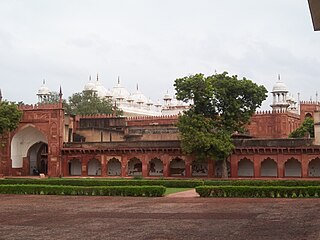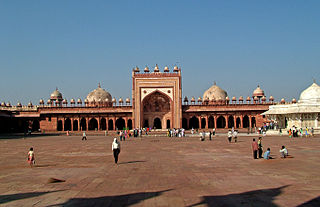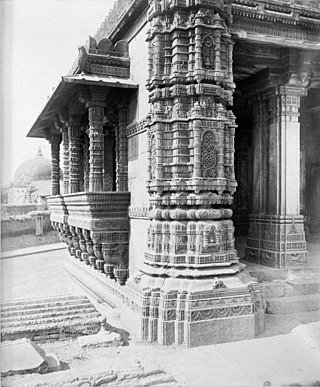See also
- Rani Sipri's Mosque, also known as Masjid-e-Nagina, in Ahmedabad, Gujarat, India
Nagina Masjid, Agra Fort is a mosque in Agra, Uttar Pradesh, India.
Nagina Masjid, or Nagina Mosque, may also refer to:
The Pearl Mosque is a name given to several religious structures:

Mughal architecture is the type of Indo-Islamic architecture developed by the Mughals in the 16th, 17th and 18th centuries throughout the ever-changing extent of their empire in the Indian subcontinent. It developed from the architectural styles of earlier Muslim dynasties in India and from Iranian and Central Asian architectural traditions, particularly Timurid architecture. It also further incorporated and syncretized influences from wider Indian architecture, especially during the reign of Akbar. Mughal buildings have a uniform pattern of structure and character, including large bulbous domes, slender minarets at the corners, massive halls, large vaulted gateways, and delicate ornamentation; examples of the style can be found in modern-day Afghanistan, Bangladesh, India and Pakistan.

The Moti Masjid is a 17th-century mosque inside the Red Fort complex in Delhi, India. It was built by Mughal emperor Aurangzeb, damaged by the Siege of Delhi, and subsequently restored by the British. Named for its white marble, the mosque features ornate floral carvings. It is an important example of Mughal architecture during Aurangzeb's reign.

Indo-Islamic architecture is the architecture of the Indian subcontinent produced by and for Islamic patrons and purposes. Despite an initial Arab presence in Sindh, the development of Indo-Islamic architecture began in earnest with the establishment of Delhi as the capital of the Ghurid dynasty in 1193. Succeeding the Ghurids was the Delhi Sultanate, a series of Central Asian dynasties that consolidated much of North India, and later the Mughal Empire by the 15th century. Both of these dynasties introduced Islamic architecture and art styles from West Asia into the Indian subcontinent.

Champaner-Pavagadh Archaeological Park, a UNESCO World Heritage Site, is located in Panchmahal district in Gujarat, India. It is located around the historical city of Champaner, a city which was founded by Vanraj Chavda, the most prominent king of the Chavda Dynasty, in the eighth century. He named it after the name of his friend and general Champa, also known later as Champaraj. The heritage site is studded with forts with bastions starting from the hills of Pavagadh, and extending into the city of Champaner. The park's landscape includes archaeological, historic and living cultural heritage monuments such as chalcolithic sites, a hill fortress of an early Hindu capital, and remains of the 16th-century capital of the state of Gujarat. There are palaces, entrance gates and arches, mosques, tombs and temples, residential complexes, agricultural structures and water installations such as stepwells and tanks, dating from the eighth to the 14th centuries. The Kalika Mata Temple, located on top of the 800 metres (2,600 ft) high Pavagadh Hill, is an important Hindu shrine in the region, attracting large numbers of pilgrims throughout the year.

The Gujarat Sultanate, or the Sultanate of Guzerat, was a late medieval Indian kingdom established in the early 15th century in Western India, primarily in the present-day state of Gujarat, India. The kingdom was founded by Muzaffar Shah I who was appointed as Tughlaq governor of Gujarat after the death of his father in 1371. Following Timur's invasion of the Delhi Sultanate, Delhi was devastated and its rule weakened considerably, so he declared himself independent in 1394, and formally established the Sultanate. The next sultan, his grandson Ahmad Shah I moved the capital to Ahmedabad in 1411. His successor Muhammad Shah II subdued most Rajput chieftains. The prosperity of the sultanate reached its zenith during the rule of Mahmud Begada. He also subdued most Gujarati Rajput chieftains and built a navy off the coast of Diu. In 1509, the Portuguese empire wrested Diu from the Sultanate in the Battle of Diu (1509). The Mughal emperor Humayun attacked Gujarat in 1535 and briefly occupied it, during which Bombay, Bassein & Daman would become a Portuguese colony, thereafter Bahadur Shah was killed by the Portuguese while making a deal in 1537. The end of the sultanate came in 1573, when Akbar annexed Sultanate of Guzerat into his empire. The last ruler Muzaffar Shah III was taken a prisoner to Agra. In 1583, he escaped from the prison and with the help of the nobles succeeded to regain the throne for a short period before being defeated by Akbar's minister Abdul Rahim Khan-i-Khanan.

Moti Masjid, one of the "Pearl Mosques", is a 17th-century religious building located inside the Lahore Fort, Lahore, Punjab, Pakistan. It is a small, white marble structure built by Mughal emperor Jahangir and modified by the architects of Shah Jahan, and is among his prominent extensions to the Lahore Fort Complex. The mosque is located on the western side of Lahore Fort, closer to Alamgiri Gate, the main entrance.
Moti Masjid, may refer to:

The Moti Masjid is a 17th-century congregational mosque located within the Agra Fort UNESCO World Heritage Site. Built by Mughal Emperor Shah Jahan, the mosque is made entirely of white marble.

The Jama Masjid is a 16th-century congregational mosque in the UNESCO World Heritage Site of Fatehpur Sikri, located in Uttar Pradesh, India. It was built by Mughal emperor Akbar, and was the largest mosque in the empire at the time of construction. The Jama Masjid's design drew from earlier mosques built by various pre-Mughal sultanates, and served as an important precedent in subsequent Mughal architecture.

The Nagina Masjid is a masjid in Agra Fort built by Shah Jahan. It is also known as the Gem Mosque or the Jewel Mosque.
The Mina Mosque or the Heavenly Mosque was built by Shah Jahan between 1631 and 1640 near Diwan-i-Khas in Agra Fort. This small mosque was built, entirely of white marble, by the Mughal king Shah Jahan for his personal use.

Rani Sipri's Mosque also known as Rani Sipri ni Masjid or Masjid-e-nagina, formerly known as Rani Asni's Mosque, is a medieval mosque in the walled city of Ahmedabad, Gujarat in India. This mosque was commissioned in 1514 by Queen Sipri, the Hindu wife of Mahmud Begada, a sultan who ruled Gujarat. It is also known as Masjid-e-Nagina because of the intricate jali carvings on its walls. In 2006–7, the Ahmedabad Municipal Corporation proposed demolishing part of the monument in order to expand a road.

Bawaman Mosque is a mosque in Champaner, western India. It is situated on the western side of one of the ancient city's fort gates, within the Champaner-Pavagadh Archaeological Park of Gujarat.

Nagina Mosque is a mosque in Champaner, Gujarat, India. It was built during the time of Mahmud Begada, in the 15th century, as were several other masjids, such as the Kevada, Bawaman, Ek Minar, Jama, Khajuri, and Shahar Ki. It has minarets, globe-like domes, and narrow stairs. It is part of the Champaner-Pavagadh Archaeological Park, a UNESCO World Heritage Site.

There are eleven different types of buildings at the UNESCO-protected Champaner-Pavagadh Archaeological Park in Gujarat, India, including mosques, temples, granaries, tombs, wells, walls, and terraces. The monuments are situated at the foot of and around the Pavagadh Hill. The Baroda Heritage Trust lists 114 monuments in the area, of which only 39 are maintained by the Archaeological Survey of India, due to limited funding. The Forest Department owns 94% of the land here, while the temple trusts and other sectarian establishments provide facilities for boarding and lodging to pilgrims and tourists. On the southern side near the foot of the hill some dilapidated houses and the foundations of Jain temples can also be seen.

Lila Gumbaj Ki Mosque in Champaner, Gujarat state, western India is one of the 114 monuments listed by the Baroda Heritage Trust that are part of the Champaner-Pavagadh Archaeological Park, a UNESCO World Heritage Site. It is located near the east gate of the former city.

Persian Inscriptions on Indian Monuments is a book written in Persian by Dr Ali Asghar Hekmat E Shirazi and published in 1956 and 1958 and 2013. New edition contains the Persian texts of more than 200 epigraphical inscriptions found on historical monuments in India, many of which are currently listed as national heritage sites or registered as UNESCO world heritage, published in Persian; an English edition is also being printed.
Nagina is a town in Uttar Pradesh, India.
The Architecture of Gujarat consists of architecture in the Indian state of Gujarat.